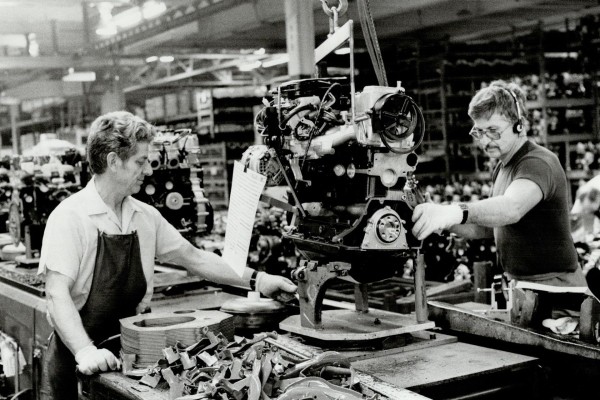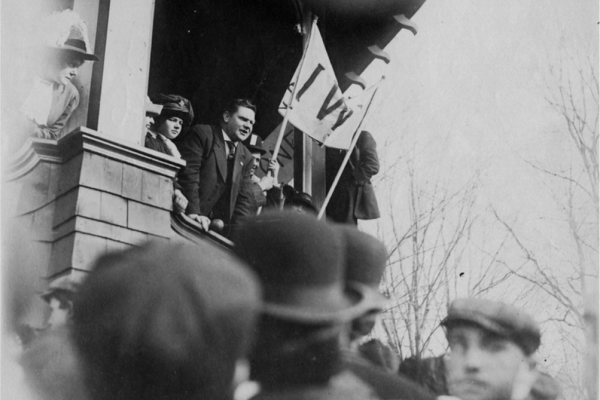Canada’s transformation under neoliberalism
This country’s reputation as possessing a “kinder, gentler” incarnation of capitalism is no longer justified at all

Former Prime Minister Stephen Harper. Photo by Travis McCrea/Flickr.
Even before that transformation began, Canada was hardly a model of inclusion, equality, and democracy. But in the latter years of the postwar expansion, Canada progressed both economically and socially. Living standards were improving quickly for most—fueled by rising real wages (which doubled in a generation) and a dramatic expansion of the social wage (including the introduction of national Medicare, unemployment insurance, and the Canada Pension Plan within six remarkable years, from 1965 through 1971). We were catching up to the US economically and surpassing it socially. And we carved a unique and somewhat independent role for the country in global economic, political, and military affairs. This confidence, hope, and momentum was symbolized by Canada’s hosting of Expo 67 in Montréal, the year of the country’s centenary—officially opened with then-Prime Minister Lester Pearson’s claim that it constituted “one of the most daring acts of faith in Canadian enterprise and ability ever undertaken.”
This expansionary postwar “golden age” eventually ran up against its own internal limits and contradictions. As in other advanced capitalist countries, the happy recipe of strong profits and business investment, rising living standards, and Keynesian welfare-state fine-tuning, began to disintegrate. The Polish economist Michal Kalecki presciently predicted after World War II, just as Keynesianism was being consolidated, that capitalism would eventually experience a “full-employment sickness.” As workers were empowered by long-run employment and income security, their expectations would grow, sparking increasing conflict with the interests of capitalist employers in maintaining a compliant, disciplined, low-cost workforce. A confident working class won a larger and larger share of the economic pie: in Canada, the labour share of GDP grew steadily through the postwar era, peaking in the late 1970s. Even worse for employers, workers demanded changes in the workplace, and in society, that constrained the freedom and power of business. The expansion of an interventionist state meant rising taxes and stronger regulations. Internationally, national liberation movements curtailed capitalism’s geographic scope. Most importantly, business investment—the underlying engine of the postwar expansion—slowed appreciably.
Neoliberalism represented a multi-faceted, deliberate, global strategy by elites (in both the financial and the real spheres of the economy) to turn the whole ship around. A generation later, it is sobering to consider how successful that strategy has been. It has clearly empowered and enriched corporations and those who own them, and put workers on the defensive everywhere. On the other hand, despite these successes, neoliberalism has not succeeded in creating a world economy which is stable (witness the dramatic events of 2008–09), efficient, or successful in meeting real human needs.
Neoliberalism has been applied harshly in Canada, consistent with the international trend, but also reflecting the unique features (and weaknesses) of Canadian capitalism. In my review of the history of neoliberalism in Canada, I identify three crucial transition points: historical moments when neoliberal principles and practices were introduced, consolidated, and ideologically cemented.
A dramatic shift in the early 1980s in the emphasis of monetary policy.
The 1989 implementation of Canada-US free trade.
A dramatic increase in the economy’s reliance on resource extraction and export (especially petroleum), beginning just after the turn of the century.
Transition 1: Monetary policy
The cannon shot that truly heralded the advent of neoliberalism in Canada was the interest rate shock that occurred here in the early 1980s, overseen by the Bank of Canada’s then-Governor Gerald Bouey. This was an echo of the similar shift in monetary policy that had occurred south of the border a couple of years earlier: the famous “Volcker shock,” engineered by US Fed chairman Paul Volcker beginning in 1978. This action, by an unelected economic authority, laid the foundation for the advent of neoliberal macroeconomic priority (abandoning full employment, prioritizing the interests of financial wealth, and ushering in a new ideology of toughlove capitalism). The interest rate shocks were cemented politically in short order with the election victories of Margaret Thatcher and Ronald Reagan (and, shortly after, Brian Mulroney in Canada—although it wasn’t until Stephen Harper’s election in 2006 that Canada experienced unforgiving, no-holds-barred neoliberal government of the sort pioneered by Thatcher and Reagan).
At that time, Canada was governed by the Trudeau Liberals, representing one of the last gasps of postwar Keynesian interventionism. In fact, in his last term Trudeau oversaw additional (but contradictory) encroachments into the private sector (including through the now-infamous National Energy Policy). But the true direction of capitalist governance was heading elsewhere, and Bouey’s decision to shock the Canadian macroeconomy with a cold monetarist bath, modeled on earlier US and UK strategies, was a crucial turning point.
Following the now-disproven belief of hardcore monetarists that the central bank could directly control the growth in the money supply (and thus wring inflation from the system), credit growth was curtailed and interest rates shot up. Prime lending rates reached an incredible, historic peak of 22.75 percent in summer 1981. Monetary authorities showed they were willing to sacrifice the course of the whole economy in order to impose this painful new doctrine. They demonstrated that reducing inflation and preserving the value of financial wealth (which suffered badly during the turbulent, militant 1960s and 1970s) was now the number one priority of economic governance.
Indeed, Bouey’s actions (reinforced by parallel measures in other countries) threw Canada’s economy into its first major postwar recession—and it was a brutal one. Tens of housands of Canadians lost their homes, unable to cope with exploding interest costs, and unemployment soared into the double digits. This was no normal cyclical downturn, however: it was engineered, and aimed to achieve a permanent shift in the expectations and behaviour of the labour market. Labour and social movements responded with some militancy: the Canadian Labour Congress organized a coalition against high interest rates (that featured a massive rally on Parliament Hill), and local activists organized unemployed workers’ centres and other fight-back initiatives. But mass unemployment was to become a deliberate, permanent feature of the economy. The new macroeconomic “consensus” (which eventually abandoned the monetarists’ religious faith in directly targeting the money supply, but pursued the same ends more adeptly through direct interest rate manipulation) justified mass joblessness as reflecting a “natural” or “non-accelerating inflation” rate of unemployment. In practice, however, this was a modern take on Marx’s century-old theory of the reserve army: the system must be managed (again, as Kalecki predicted) to maintain sufficient unemployment to threaten and discipline all workers.
Bouey was succeeded at the Bank of Canada by John Crow, who engineered an even more aggressive disinflation in the early 1990s (and that sparked another major recession), and ushered in the era of formal inflation targeting. Subsequent leadership at the Bank has proven, in various ways, to be somewhat more flexible and pragmatic (especially in the wake of the 2008–09 financial meltdown). But the fundamental tenets of neoliberal monetary theory have become well-entrenched indeed. The idea that an unelected (so-called “independent”) monetary authority must focus on controlling inflation at a very low rate, with no direct regard to other economic or social priorities (including unemployment), is now virtually sacrosanct in Canadian political economy.
Aggregate productivity in the business (private) sector of the economy, comparing Canadian productivity with US levels.
Transition 2: Free trade
The Trudeau government appointed former Finance Minister Donald Macdonald to lead a wide-ranging commission into Canada’s economic prospects. Despite Trudeau’s own interventionist leanings, the Macdonald Commission ushered in a highly neoliberal and globalized vision of economic policy. Its report, issued in 1985 (by which time Trudeau had already been replaced by Mulroney), recommended a comprehensive free trade agreement with the US (and the effective abandonment of previous sector-specific industrial and trade strategies, such as the highly successful Auto Pact). Mulroney endorsed that goal with gusto (despite never having mentioned free trade during his 1984 election campaign), and kicked off talks at the infamous Shamrock Summit with Ronald Reagan in 1985.
Canadian negotiators (led by the belligerent Simon Reisman) argued the deal was necessary to preserve access for Canadian products to US markets. Canadian exports had encountered sporadic (but not widespread) protectionist interference from the US during the 1981–82 recession (including lumber, agricultural goods, and a few other products). A free trade deal was supposed to win exemption for Canadian products from any US countervail action; the quid pro quo would be guaranteed US access to Canadian energy resources (through a unique proportional energy sharing clause that has still never been replicated in international trade law). However, American negotiators would not grant a blanket exemption to Canadian-made goods from countervail. The next-best option for Mulroney was to create binding dispute settlement panels to supposedly ensure fair application of each nation’s countervail laws. That was a significant failure for the Canadian negotiators (and in practice, those panels have not consistently curtailed US protectionism).
But the Canadian business community, despite some initial divisions, was largely supportive of the trade-off direction, and Mulroney sealed the deal in 1988. However, the deal could not be implemented until the Conservatives were re-elected in the electrifying 1988 federal election. John Turner’s Liberals fiercely contested the deal (more aggressively than did Ed Broadbent’s NDP, who worried more about how strategic anti-free-trade voting might help the Liberals, than about stopping the deal). Mulroney won a majority with 43 percent of the vote, and the deal was implemented effective January 1, 1989. America won guaranteed access to Canadian energy (setting the institutional stage for the subsequent bitumen boom), but Canadian products did not get secure access to US markets—so the historic tradeoff promised by the deal was rather one-sided. Indeed, 20 years after the FTA, Canada’s share of US imports was lower than when the deal was signed, repudiating the promise of our supposed “special access” to the world’s largest market.
In the initial years of free trade, Canadian industry suffered a tremendous downturn—but it was not solely because of the trade deal. Canadian interest rates were high, the dollar soared (to above 90 cents US), and the economy entered a largely self-inflicted recession. Manufacturers reoriented their production to a continental market; in many cases this involved closing smaller Canadian “branch plants” that had previously served the domestic market. After that initial shake-out, however, and in the wake of the later downturn in the Canadian dollar in the mid-1990s, Canadian manufacturing rebounded despite the constraints of the trade deal. Government economic, social, and fiscal policies gradually converged with US benchmarks in many, but not all, areas—especially through the historic cuts in EI, provincial transfers, and other key programs engineered by Finance Minister Paul Martin in the mid-1990s. This reflected the indirect constraints of competitiveness within the harmonized continental system—even though there was nothing in the trade deal itself that “forced” Canada to weaken its social programs.
Perhaps the most important legacy of the Canada-US free trade deal was the abandonment by the Canadian business class of any distinct national strategy for accumulation and development. Whereas previously leading Canadian firms and executives in many sectors were amenable to nationally oriented strategies (including some limits on trade and foreign investment), after the FTA they began to identify almost unanimously with a continentalist (and furthermore, a globalist) vision. The FTA was expanded to include Mexico five years later. This accentuated the downward pressure on Canadian wages and standards, and has facilitated an enormous southward migration of investment and production in manufacturing (represented by Canada’s current $22-billion bilateral trade deficit with Mexico). But the far bigger structural impact on Canada was felt through the FTA with our enormous southern neighbour—and the historic shift in national consciousness that that deal produced.
Government spending as share of GDP.
Transition 3: Back to staples
Despite an initial wave of plant shutdowns, the FTA itself did not produce a one-dimensional trend of deindustrialization of Canada. But it laid the institutional and political framework for a huge shift in the focus of Canada’s economy that would become visible over a decade later. Beginning just after the turn of the century, it is now clear that Canada’s economy has clearly shifted onto a path of renewed dependence on the extraction and export of raw natural resources (or “staples”), led by a massive expansion of bitumen production and export from northern Alberta.
Several factors coincided to create this historic U-turn in the trajectory of Canadian economic development (and political culture). The US recession that followed the 9/11 terrorist attacks, combined with delays at border crossings, resulted in a sharp downturn in southbound Canadian manufactured exports. The spectacular growth in China produced a surge in global demand for basic resource commodities (including petroleum), pushing prices for minerals, energy, and agricultural products sharply upward (from the low levels experienced in the 1990s). Speculative forces (in futures markets and other derivatives) greatly exaggerated that upsurge. A parallel and largely speculative run-up in the Canadian currency dramatically undermined the relative competitiveness of Canadian-made exports. With oil prices far above the $100 (US) per barrel mark by mid-decade, and extraordinary profits in the oil industry as a result, the oil majors (largely foreign-owned) invested tens of billions of dollars in expanding Canadian production (mostly through new bitumen extraction projects). The energy-sharing provisions of the Canada–US FTA provided those investments with an extra degree of prominence in the minds of US energy executives. The resulting mega-boom (the expansion of bitumen production in the last decade collectively represents one of the largest industrial projects in the history of humanity) created major stresses in regional infrastructure, regional labour markets, and transportation (including major bottlenecks in pipeline capacity to deliver all this new production to market). It has certainly enerated important jobs and spin-off economic activity, focused in western Canada. But the boom has also distorted Canada’s economy, federation, and environment in many worrisome and damaging ways.
Petroleum has become the dominant staples export from Canada, but other resource-based industries (including mining and agriculture) also experienced high profits and new investment. Largely because of the impact of an overvalued currency on competitiveness, manufacturing and other export sectors (including tourism, transportation, and business services) experienced absolute and relative decline. The cumulative result was a historic U-turn in the composition of Canada’s merchandise trade, with our traditional reliance on staples exports reasserting its dominance. One statistic is especially telling in this regard: at the turn of the century, value-added products (including transportation equipment, machinery, and consumer goods) accounted for over 60 percent of total Canadian exports. A decade later, that share had fallen to under a third. Unprocessed or barely processed resource products once again accounted for the lion’s share of total exports (over two thirds). Whereas for several postwar decades (including the 1990s) Canada had gradually escaped its legacy as “hewers of wood and drawers of water,” our staples reliance was strongly reconstituted—with the additional moniker “scrapers of tar” added to our list of national job descriptions.
There are important political parallels to this economic transformation. The rise of a powerful, largely foreign-owned petroleum industry has shifted Canadian politics, represented most powerfully by the rise of Stephen Harper’s Alberta-centred Conservatives to government in 2006.
Measuring the transitions
The neoliberal transformation of Canada over the past generation can be empirically documented by many different indicators. Here are three that encapsulate, by my reckoning, the deep structural shifts in the direction of the economy and society.
Figure 1 measures Canada’s total exports of goods and services, as a share of total GDP. This is an aggregate but imperfect measure of Canada’s overall engagement with the international economy: to what extent is Canada’s economy oriented toward meeting international demand, versus domestic demand? (The measure overstates total dependence on trade, since some of the value-added encompassed within our exports had previously been imported, through imports of raw materials, parts, and technology. Despite this methodological problem, the measure aptly reveals trends over time.)
The key transition points discussed above are all clearly visible on Figure 1, and marked accordingly. During the initial decades of the postwar expansion, Canada’s trade-intensity grew slowly but steadily, driven by gradual industrialization, reaching over 25 percent of GDP by 1980. But it then plateaued for a decade: this reflected the big shift in monetary policy, the resulting recession (at home and abroad), a general loss of dynamism by Canadian businesses, and (to a small extent) US protectionism. After 1989, however, the FTA dramatically increased trade as a share of total GDP, reinforced by the late-1990s expansion of manufacturing exports. The export ratio peaked in 2000 at over 45 percent of GDP—dramatically higher after just a decade of free trade.
Other quantitative measures also describe Canada’s changing engagement with the global economy during these subsequent phases of the neoliberal transformation. Foreign direct investment flows to and from Canada have changed dramatically, but in different ways, during this period. Reducing Canada’s reliance on FDI had been an ongoing policy preoccupation during the postwar expansion (motivating various interventions, including most famously the implementation of the Foreign Investment Review Act by the Trudeau government in 1973). In practice, incoming FDI had begun declining steadily as a share of Canada’s GDP in the early 1960s, reaching a historic low (of under 20 percent of GDP) by the early 1980s. After the FTA, however, incoming FDI grew sharply, nearly doubling as a share of GDP by the late 2000s (in part driven by huge foreign takeovers of important resource companies during that decade’s commodities boom). However, outgoing FDI by Canadian corporations (mostly by banks and mining firms) grew even more dramatically, quadrupling relative to Canadian GDP (from just 10 percent in 1980 to nearly 40 percent by 2010). Indeed, by the mid-1990s the stock of outward FDI by Canadian corporations exceeded inbound FDI by foreign corporations for the first time in Canadian history. This indicates that the effect of the deal (and globalization more generally) has been to foster a general internationalization of capital, flowing in large amounts both ways over the border.
Today, about 30 percent of corporate operating revenues in Canada accrue to companies that are foreign-controlled. This ratio has not changed much between 1999 and 2011 (most recent data).
Nevertheless, given the concentrated nature of outbound FDI (in financial and resource industries), and the increasingly deindustrialized and resource dependent nature of the Canadian economy, the combined effect of these flows has been to reinforce Canada’s renewed status as a resource supplier. With Canada’s renewed reliance on staple exports, however, trade intensity declined sharply in the new century, reversing most of the FTA-inspired growth in trade. Resource exports grew, but they were more than offset by declines in other exports (especially manufacturing, but also tourism and services). Ironically, exports as a share of GDP fell more under Stephen Harper than under any other postwar Prime Minister, making a mockery of his party’s supposed “pro-trade” agenda. (Of course, promoting Canadian exports and signing free trade agreements are not at all synonymous.)
How do Canadian mega giants match up with corporate mega giants of other countries? According to Fortune magazine’s ranking of global corporations, there is not one Canadian company among the largest 250 in the world ranked by revenue. There are nine Canadian firms in the next 250, but they also reveal the relative underdevelopment of Canada’s business class: dominated by banks, holding companies, and resource producers.
Figure 2 shows another dimension to Canada’s economic convergence with, and then divergence from, the US. It is a measure of aggregate productivity in the business (private) sector of the economy, comparing Canadian productivity with US levels. At the end of World War II, as mentioned, Canada was a poor northern cousin: the average job being 70 percent as efficient (measured by real value-added per hour) as in the US. (There are many different factors that affect productivity, of course—including capital intensity, technology, the sectoral make-up of the economy, and working conditions.) Canada converged with US levels through the postwar expansion. Thanks to rapid industrialization (often supported by proactive state policies and strategies), productivity and real incomes grew significantly faster in Canada than in the US, and Canadian productivity reached almost 95 percent of US levels by the time the Macdonald Commission issued its report calling for comprehensive free trade. Ironically, FTA proponents at the time argued that free trade (via open competition) would eliminate the vestigial productivity gap. In fact, exactly the reverse occurred. Macroeconomic stagnation, weak capital spending, a chronic lack of initiative and innovation on the part of most Canadian business, and more recently the growing dominance of resource extraction (which normally experiences falling productivity over time, as more accessible reserves are depleted) have produced a sustained downturn in relative Canadian productivity through-out the neoliberal era. Incredibly, relative productivity in Canada is now lower (compared to the US) than it was in 1950. Canada’s great “catch-up” has been completely undone.
Table 1 summarizes a final indication of the impact of neoliberalism in Canada, once again in comparison to the US. It reports total government spending, by all levels of government, as a share of GDP. Again, this measure is imperfect: there is no automatic correlation between the size of government spending, and the social role played by government programs. (Huge spending on military programs, prisons, and similar projects are a case in point.) Nevertheless, it provides a rough measure of the relative scope of state intervention in the economy. And remembering that (in the long run, at least), government spending must be roughly matched by government revenues, this is also an approximate indicator of the state’s fiscal capacity. At the beginning of the neoliberal era, Canada’s government was considerably more expansive than that in the US, largely reflecting the impact of the universal public programs introduced in the 1960s and 1970s. Initially, the gap between the two countries actually grew. After all, the cost of unemployment insurance and other income security programs increased dramatically in Canada in the wake of the successive recessions of 1981–82 and 1990–92.
It was only with the successive political and fiscal attack on those programs (justified in part by the claim that they were no longer “sustainable” in an era of free trade) that the scale of Canada’s government began to shrink rapidly. Spending cuts were then matched by tax cuts (disproportionately targeted at corporations and those who own them). Government activity in the economy (by this measure) was cut by 10 percentage points of GDP within a decade—a stunning and unprecedented withdrawal. By 2013, most of the gap in government spending had been eliminated between Canada and the US.
Perhaps this is the strongest indicator that under neoliberalism, Canada’s reputation as possessing a “kinder, gentler” incarnation of capitalism is no longer justified at all—to the extent that it ever was.
Jim Stanford is an economist with Unifor. He is the author of Economics for Everyone (published in 2008 by Pluto Press and the Canadian Centre for Policy Alternatives), which has been translated into six languages.










